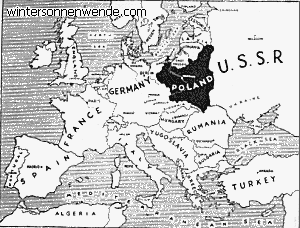 |
 Introduction
Poland is a country which, in its present form, was founded after the Great
War. In order to obtain some idea of its size, one must remember that it is
almost three times as large as England.
Poland is bounded on the North by Latvia, Lithuania, East Prussia, Danzig and the Baltic, on the East by Russia, and on the West by Germany, while in the South it borders Rumania, Slovakia and Hungary. The part extending to the Baltic forms a wedge between East Prussia and the rest of Germany, and is generally referred to as the Corridor. The country comprises a part of White Russia, a part of the Ukraine, Upper Silesia, which voted in favour of a union with Germany after the Great War, and, in addition to the Corridor, several mainly non-Polish territories, while the originally Polish kernel is in the centre of the present State. The Vistula is the main river, but its commercial importance has been reduced considerably since the War, and it is, as Polish figures show, not the main commercial highway. Poland's seaport, Gdynia, shares with Danzig the main part of overseas commerce. Gdynia has been extended of recent years. Danzig is not part of Poland, but is called a Free [8] State. It has its own officials, its own postage stamps, its own currency and its own laws; but it forms with Poland a customs union, so that Poland was permitted by the terms of the peace treaty to post her customs officials there. In former centuries, under the Polish kings, the country played an important part in European history every now and then. Later on, it was divided between the neighbouring States, Russia obtaining the lion's share. There were three partitions altogether. The Poles wished to regain their independence and struggled against the Russians. During the Great War their opportunity came, and as early as 1916 Germany promised the representatives of the Poles independence. When the frontiers of the new Poland were fixed, vast tracts of non-Polish land were included, and there were loud protests in England when Upper Silesia was added as well. In the course of time, however, this was forgotten, and most people now believe that the provinces making up the Polish Republic have always been Polish. The Poles are of Slavonic origin, but absolutely distinct from the Russians. Their main occupation is agriculture, but there are also important manufacturing centres, especially in the former German part in the South-West. The people are almost all Roman Catholics.
Geographically and historically, the whole country [9] now composing Poland belongs to no single,
compact State system, but comprises a number of various sections synthetically
linked up under the rule of Warsaw. Ethnographically, the South is Ukrainian,
much of the West German, the extreme North also German, part of
the North-East Russian, while the rest of the Republic is mainly Polish, but with
no inconsiderable admixture of other nationalities. The present frontiers were
mainly due to Polish claims to have owned these areas in earlier centuries.
|









